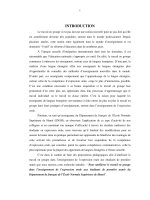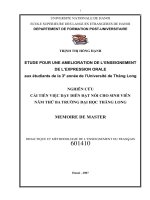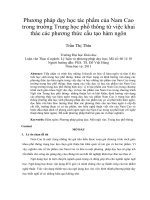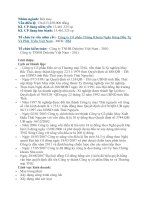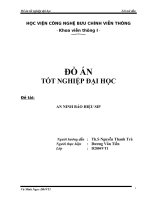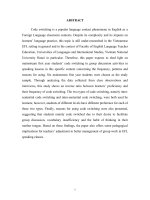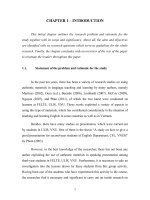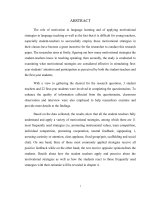VIỆC KHAI THÁC các PHƯƠNG PHÁP tạo ĐỘNG lực TRONG GIẢNG dạy kỹ NĂNG nói DO SINH VIÊN năm THỨ tư THỰC HIỆN TRONG kì THỰC tập một NGHIÊN cứu NHIỀU đối TƯỢNG tại KHOA sư PHẠM TIẾNG ANH TRƯỜNG đại học NGOẠI NGỮ
Bạn đang xem bản rút gọn của tài liệu. Xem và tải ngay bản đầy đủ của tài liệu tại đây (1.16 MB, 109 trang )
ABSTRACT
The role of motivation in language learning and of applying motivational
strategies in language teaching as well as the fact that it is difficult for young teachers,
especially student-teachers to successfully employ those motivational strategies in
their classes have become a great incentive for the researcher to conduct this research
paper. The researcher aims at firstly, figuring out how many motivational strategies the
student-teachers know in teaching speaking; then secondly, the study is conducted to
examining what motivational strategies are considered effective in stimulating first-
year students’ attention and participation as perceived by both the student-teachers and
the first-year students.
With a view to gathering the desired for the research questions, 3 student
teachers and 22 first-year students were involved in completing the questionnaires. To
enhance the quality of information collected from the questionnaire, classroom
observation and interview were also employed to help researchers examine and
provide more details to the findings.
Based on the data collected, the results show that all the student teachers fully
understand and apply a variety of motivational strategies, among which there are 11
most frequently used strategies (i.e. promoting instrumental values, team competition,
individual competition, promoting cooperation, neutral feedback, signposting 1,
arousing curiosity or attention, class applause, fixed group/pair, scaffolding and social
chat). On one hand, three of those most commonly applied strategies receive all
positive feedback while on the other hand, the rest receive opposite opinionsfrom the
students. Details about how the student teachers apply and perceive about the
motivational strategies as well as how the students react to those frequently used
strategies with their rationale will be revealed in chapter 4.
i
TABLE OF CONTENTS
AKNOWLEDGEMENTS
…………………………………………………………
ii
ABSTRACT…………………………………………………………………… iii
LIST OF TABLES
………………………………………………………………
ix
LIST OF FIGURES
……………………………………………………………
x
LIST OF ABBREVIATIONS
……………………………………………………
xi
CHAPTER 1: INTRODUCTION
…………………………………………………
1
1.1. Statement of the problem and the rationale for the study ……………. 1
1.2. Aims and objectives of the study …………………………………… 2
1.3. Scope of the study …………………………………………………… 3
1.4. Significance of the study ……………………………………………… 4
1.5. Organization of the paper …………………………………………… 4
CHAPTER 2: LITERATURE REVIEW
………………………………………….
6
2.1. Teaching L2 speaking ………………………………………………… 6
2.1.1. Definition of speaking ……………………………………………… 6
2.1.2. Approaches to the teaching of L2 speaking ……………………… 6
2.1.2.1. The Grammar – translation Method ……………………………… 6
2.1.2.2. The Direct Method and Audiolingualism ………………………… 7
2.1.2.3. Communicative Language Teaching ……………………………… 7
2.2. Definition and sources of motivation ………………………………… 8
2.3. Motivation in psychology …………………………………………… 9
2.3.1. Motivational theories and constructs ……………………………… 9
2.3.1.1. Future time perspective (FTP) …………………………………… 9
2.3.1.2. Goal content perspective ………………………………………… 9
2.3.1.3. Self-determination theory ………………………………………… 10
2.3.2. Motivation in second language learning …………………………… 10
2.3.3. The importance of motivation in English language teaching ………. 11
2.3.4. Approaches of motivation research on L2 field …………………… 12
2.3.5. Framework of motivational strategies ………………………………. 17
CHAPTER 3: METHODOLOGY
………………………………………………
19
ii
3.1. Research design ……………………………………………………… 19
3.1.1. Case study approach …………………………………………………. 19
3.1.2. Research setting …………………………………………………… 19
3.2. Sampling and participants …………………………………………… 20
3.2.1. The trainee teachers………………………………………………… 21
3.2.1.1. Trainee teacher X1 ………………………………………………… 21
3.2.1.2. Trainee teacher X2 ………………………………………………… 22
3.2.1.3. Trainee teacher X3 ………………………………………………… 22
3.2.2. The first year students ……………………………………………… 23
3.3. Data collection instruments ……………………………………………. 24
3.3.1. Observation ………………………………………………………… 24
3.3.1.1. Reasons for choosing observation ………………………………… 24
3.3.1.2. Observation scheme ……………………………………………… 24
3.3.2. Questionnaires ………………………………………………………. 26
3.3.2.1. Reasons for choosing questionnaires ……………………………… 26
3.3.2.2. Questionnaire format and content ………………………………… 26
3.3.3. Interviews ……………………………………………………………. 27
3.3.3.1. Reasons for choosing interviews …………………………………. 27
3.3.3.2. Interview format and content ……………………………………… 27
3.4. Data collection procedure …………………………………………… 28
3.5. Data analysis procedure ……………………………………………… 30
CHAPTER 4: FINDINGS AND DISCUSSION
…………………………………
32
4.1. Research question 1: What motivational strategies are most frequently used
by the student-teachers during their practicum? ……………………………. 32
4.1.1. Case X1 ……………………………………………………………… 33
4.1.2. Case X2 ……………………………………………………………… 37
4.1.3. Case X3 ……………………………………………………………… 39
4.2. Research question 2: What do students-teachers perceive about the most
frequently used motivational strategies regarding typology, timing to use and
situations in which the strategies should be used? ………………………… 42
4.2.1. Case X1 ……………………………………………………………… 42
4.2.2. Case X2 ……………………………………………………………… 43
4.2.3. Case X3 ……………………………………………………………… 44
4.3. Research question 3: In what way do those most frequently used strategies
motivate students to engage in speaking activities? In what ways do those most
frequently used strategies prohibit students to engage in speaking activities?
…………………………………………………………………………. 45
iii
4.4. Research question 4: What are the students’ preferences for motivational
strategies of student-teachers? ……………………………………… 49
CHAPTER 5: CONCLUSION
…………………………………………………….
52
5.1. Major findings of the study ……………………………………………. 52
5.2. Pedagogical implications ……………………………………………… 53
5.3. Limitations …………………………………………………………… 53
5.4. Suggestions for further studies ……………………………………… 54
REFERENCES
……………………………………………………………………
56
APPENDICES ……………………………………………………………………. 59
APPENDIX 1. Motivational variables and their descriptions ……………. 59
APPENDIX 2. Observation checklist ……………………………………… 62
APPENDIX 3. Questionnaire for student-teachers ……………………… 67
APPENDIX 4. Questionnaire for first-year students ……………………… 70
APPENDIX 5. X2’s charts illustrating her frequency of using motivational
strategies. ………………………………………………………………………… 75
APPENDIX 5A. X2’s frequency of using motivational strategies, perceived by
first-year students ………………………………………………… 75
APPENDIX 5B. X2’s frequency of using strategies in creating the basic
motivational conditions, perceived by first-year students ………………………. 75
APPENDIX 5C. X2’s frequency of using strategies in generating initial
motivation, perceived by first-year students ……………………………………… 76
APPENDIX 5E. X2’s frequency of using strategies in maintaining and protecting
motivation, perceived by first-year students ………………………… 76
APPENDIX 5F. X2’s frequency of using strategies in encouraging positive
retrospective self-evaluation, perceived by first-year students ………… 77
APPENDIX 6. X2’s charts illustrating her frequency of using motivational
strategies ………………………………………………………………………… 78
APPENDIX 6A. X3’s frequency of using motivational strategies, perceived by
first-year students ………………………………………………… 78
APPENDIX 6B. X3’s frequency of using strategies in creating the basic
motivational conditions, perceived by first-year students ……………………… 78
APPENDIX 6C. X3’s self-perceive about her frequency of using strategies
in creating basic motivational conditions …………………………………………. 79
iv
APPENDIX 6D. X3’s frequency of using strategies in generating initial
motivation, perceived by first-year students ……………………………………… 79
APPENDIX 6E. X3’s frequency of using strategies in maintaining and protecting
motivation, perceived by first-year students ………………………… 80
APPENDIX 6F. X3’s self-perceive about her frequency of using strategies
in maintaining and protecting motivation ………………………………………… 81
APPENDIX 6G. X3’s frequency of using strategies in encouraging positive
retrospective self-evaluation, perceived by first-year students …………………. 81
APPENDIX 7. Interview guiding questions ……………………………… 82
APPENDIX 7A. Interview guiding questions for the student-teachers …… 83
APPENDIX 7B. Interview guiding questions for the first-year students… 84
APPENDIX 8. Student teachers’ interview transcript …………………… 85
APPENDIX 8A. Student teacher X1’s interview transcript .………………. 85
APPENDIX 8B. Student teacher X2‘s interview transcript .………………. 88
APPENDIX 8C. Student teacher X3‘s interview transcript .………………. 91
APPENDIX 9. Students’ interview transcript …………………………… 94
v
LIST OF TABLES
TABLE PAGE
Table 1: Background of the first year students
………………………………
23
Table 2: Observational variables measuring learner’s motivated behavior …. 25
Table 3: Data collection procedure
…………………………………………….
28
vi
LIST OF FIGURES
FIGURE PAGE
Figure 1: Gardner and MacIntyre (1993)’s socioeducational model of Second
Language Acquisition
12
Figure 2: The role of Aptitude and Motivation in L2 Learning (Gardner
2000)
13
Figure 3: Components of Foreign Language Learning Motivation (Dornyei
1994)
14
Figure 4: Williams and Burden (1997)’s framework of motivational
components
15
Figure 5: Dornyei (2001)’s process-oriented approach 16
Figure 6: Dörnyei (2001)’s motivational teaching practice 18
Figure 7: X1’s frequency of using motivational strategies, percieved by first-
year students
33
Figure 8: X1’s frequency of using strategies in creating the basic
motivational conditions, perceived by first-year students
34
Figure 9: X1’s frequency of using strategies in generating initial motivation
perceived by first-year students
35
Figure 10: X1’s frequency of using strategies in maintaining and protecting
motivation, perceived by first-year students
35
Figure 11: X1’s self-perceive about her frequency of using strategies in
maintaining and protecting motivation
36
Figure 12: X1’s frequency of using strategies in encouraging positive 37
vii
retrospective self-evaluation, perceived by first-year students
Figure 13: Students’ preference towards motivational strategies 49
Figure 14: Students’ preference towards the three cases’ lessons 50
LIST OF ABBREVIATIONS
CLT Communicative Language Teaching
FELTE Faculty of English Language Teacher Education
ULIS University of Languages and International Studies
VNUH Vietnam National University, Hanoi
EFL English as Foreign Language
ESL English as a Second Language
L2 The second language
ELT English Language Teaching
ELT 2 ESL/EFL classroom techniques and practices
(five credits, semester six and seven)
ELT 4 Pedagogical Techniques
(two credits, semester eight)
viii
CHAPTER 1: INTRODUCTION
This initial chapter outlines the research problem and rationale for the study
together with its aims and objectives, the scope and the significance of the paper.
Particularly, it is in this chapter that four research questions are identified to serve as
guidelines for the whole study. Finally, the chapter concludes with the organization of
the paper to orientate the readers throughout the paper.
1.1. Statement of the problem and the rationale for the study
Having been influenced by Confucian classroom environment where teachers
controlled over students in all ways including times to speak and raise their voice,
Vietnamese students, have traditionally kept silence during lessons to show their
respects to teachers. On one hand, this way helps teachers to successfully manage the
class. On the other hand, it gradually turns students into passive ones, which recently
has been considered ineffective in teaching foreign languages since students do not
have chances to practice in real life situations but just learn by heart rules and words to
automatically do exercises. In such a globalization era, emphasis must be put on the
communicative function of the foreign language.
Additionally, despite the fact that over the past few years, Communicative
Language Teaching (CLT) method has been adopted extensively in Vietnam,
Grammar-Translation is still dominated in teaching English at high school since
almost high school students only concentrate on passing examinations containing no
further communicative skills. As a matter of fact, it is a common problem among first-
year mainstream students at FELTE, ULIS that they are reluctant to speak English in
the classroom as they have just transformed from grammar-focused lesson in high
schools to a more communicative-oriented learning environment in the university
which requires them to communicate more in English. Therefore, they need to be more
motivated and the role of teachers in motivating them is unquestionably emphasized.
1
Generally, motivation has been recognized by teachers and researchers as “one
of the key factors that influences the rate and success of second/foreign language (L2)
learning” (Dörnyei 1998, p.117). Consequently, it is vital for language teachers to
make use of motivation in their teaching. One way that helps teachers is to apply
motivational strategies defined as “techniques that promote the individual’s goal-
related behavior” and referred to “those motivational influences that are consciously
exerted to achieve some systematic and enduring positive effect” (Dörnyei 2001, p.27)
in language classroom in order to stimulate students’ interest in language learning
process. However, it is obviously difficult for young teachers, especially student-
teachers who are learning to be teachers, to successfully apply those motivational
strategies in their classes due to their lack of experiences. Recently, there are some
research papers regarding to the student-teachers and their practicum, varying on the
topics. Nevertheless, very few of those studies investigated into applying motivational
strategies in teaching speaking. At the first time teaching and managing a large class,
how the student-teachers perceive and apply motivational strategies in teaching
speaking is still on question.
The above facts have raised the need of the researcher to conduct a study
investigating into a context in which the student-teachers who are learning to motivate
students and first-year mainstream students who need to be motivated to speak be
together. The study is entitled: “The exploitation of motivational strategies in
teaching speaking by fourth-year students in their teaching practicum at English
Division I: a multi-case study at Faculty of English Language Teacher Education,
ULIS-VNUH.”
1.2. Aims and objectives of the study
This study aims at exploring how the fourth-year students exploit the
motivational strategies in teaching speaking to the first-year students during their
practicum at FELTE, ULIS-VNUH. In order to achieve this aim successfully, the
researcher would like to shed light on the following matters. Firstly, the researcher
2
wants to figure out how many motivational strategies the student-teachers know in
teaching speaking. Secondly, the study is conducted to examine what motivational
strategies are considered effective in stimulating first-year students’ attention and
participation as perceived by both the student-teachers and the first-year students.
In sum, the aims of the study can be summarized into four following research
questions:
i. What motivational strategies are most frequently used by the student-teachers
during their practicum?
ii. What do students-teachers perceive about the most frequently used motivational
strategies regarding typology, timing to use and situations in which the
strategies should be used?
iii. In what way do those most frequently used strategies motivate students to
engage in speaking activities? In what ways do those most frequently used
strategies prohibit students to engage in speaking activities?
iv. What are the students’ preferences for motivational strategies of student-
teachers?
1.3. Scope of the study
As motivation is a broad aspect with various ways to categorize, within the
framework of this study, the researcher does not intend to study all types of motivation
but would like to focus merely on the strategies that can be applied to stimulate
possible motivations in speaking periods. The reason is that in the lessons of other
skills, if students are not motivated, classroom activities can still be carried out to
some extent though they will become less interesting and effective. Nevertheless, in
speaking lessons, demotivating factors can easily prevent students, especially shy
ones, from raising their voice and accordingly speaking activities can hardly be
undergone and they cannot improve their skill at al.
3
Since this study is designed as a multi-case study, the target participants are
particularly three student-teachers conducting their practicum at English Division 1,
FELTE, ULIS, VNUH and the class which they are in charge of teaching speaking.
1.4. Significance of the study
Once having completed, this research would serve as an investigation into the
context of teaching practicum in general and the use of motivational strategies in
teaching speaking to first year mainstream students, FELTE, ULIS – VNUH in
particular. Therefore, it can be beneficial for teachers, students as well as researchers
who are interested in the issue. Specifically, language teachers can consult this to be
more aware of their students’ attitudes towards the motivational practice, which can
lead to ways of adjusting their teaching methods and referring the most useful
strategies explored to enhance students’ motivation in speaking lessons. Moreover, this
research could also be considered as a reference for ELT teachers to make changes to
the course to help their students use motivational strategies more effectively.
Additionally, the findings from this research could help not only the student-teachers
improve their motivating techniques but also the students to be more motivated in
speaking lessons and improve their skills. Finally, researchers who have an interest in
this issue can refer to this study for a reliable and updated source of information for
further studies.
1.5. Organization of the paper
The rest of the paper includes the following chapters:
Chapter 2 (Literature review) provides the theoretical background of the study,
including discussions of the key concepts and related studies.
Chapter 3 (Methodology) describes the research setting, participants,
instruments of data collection as well as the procedure employed to carry out data
analysis.
Chapter 4 (Findings and discussion) presents, analyzes and discusses the results
that the researcher found out from the collected data according to the four research
4
questions. This chapter contains four smaller parts, equivalent to give answers to the
four research questions.
Chapter 5 (Conclusion) summarizes the answers to the four research questions,
several pedagogical recommendations concerning the research topic, the limitations of
the research as well as some suggestions for further studies. Following this chapter are
the References and Appendices.
5
CHAPTER 2: LITERATURE REVIEW
This chapter, as its name suggested, provides a brief review of the literature
related to this study and lays the solid foundation for the development of subsequent
parts of the paper. Initially, key terms such as speaking, motivation and motivational
strategies will be defined together with the related issues such as approaches to the
teaching speaking or the types and sources of motivation in education. Considerable
efforts will be focused on reviewing various approaches of researching motivation in
the second language field and the framework the researcher is going to follow.
2.1. Teaching L2 speaking.
2.1.1. Definition of speaking
Florez (1999) defined speaking was “an interactive process of constructing
meaning that involves producing and receiving and processing information” (cited in
Balley 2005, p.2). It is “often spontaneous, open- ended and evolving”, but it is not
completely unpredictable. In other words, “speaking consists of producing systematic
verbal utterances to convey meaning”. (Balley 2005, p.2) Moreover, in his own view,
Mackey (1965) shows that “oral expression involves not only the use of the right
sounds in the right patterns of rhythm and intonation, but also a choice of words and
inflections in the right order to convey the right meaning”(cited in Bygate 1997, p.5).
According to Mackey, for the student who wants to be good at speaking, he or she has
to choose the right forms, put them in correct order, sound it like native speaker and
even produce the right meanings.
2.1.2. Approaches to the teaching of L2 speaking
2.1.2.1. The Grammar- translation Method
In the Grammar- translation method, students are taught to analyze grammar
and to translate from one language to another. The Grammar translation method,
therefore, does not really prepare students to speak English, and it is not entirely
6
appropriate for students who want to improve their speaking skills. This method is not
consistent with the goals of increasing English learners’ fluency, oral production or
communicative competence. In grammar- translation lessons, speaking consists largely
of reading translations aloud or doing grammar exercises orally. There are few
opportunities for expressing original thoughts or personal needs and feelings in
English (Bailey 2005).
2.1.2.2. The Direct Method and Audiolingualism
The Direct method focuses on “everyday vocabulary and sentences” (Richards
& Rodgers 1986, cited in Bailey 2005, p.17) and lessons were conducted entirely in
the target language. The Direct Method emphasizes speaking in that “new teaching
points were introduced orally” rather in writing. Also, lessons emphasize speaking and
listening, which were practiced “in a carefully graded progression organized around
question and answer exchanges between teachers and students”.
The Direct Method strongly influences the development of the Audiolingual
Method. Nunan (2003) points out that in Audiolingualism, speaking is taught by
having students repeat sentences and recite memorized dialogues from the textbook.
Repetition drills- a hallmark of the Audiolingual Method- are designed to familiarize
students with the sounds and structural patterns of the language. Lessons followed the
sequence of presentation, practice, and production. (cited in Bailey 2005, p.17).
2.1.2.3. Communicative Language Teaching
Because mentioned methods did not lead to fluent and effective communication
in real- life situations, the Communicative Language Teaching (CLT) evoked. The
goal of language teaching in the light of CLT is to develop communicative
competence. CLT favors interaction among small numbers of learners with a purpose
to maximize the time each learner learns and uses languages, shares information and
negotiates meaning. Though interaction learners’ experience can be modified, many
kinds of learning strategies made aware and applied, and especially classrooms move
away from teacher- centeredness to learner- centeredness, which is an essential
7
element to raise learners’ motivation in language learning. CLT features more
interaction- based activities, such as role- plays and information gap tasks. Pair work
and group work are typical organizational features of interaction- based lessons in
CLT.
In summary, among some approaches of the language teaching methods
mentioned above, CLT is the most appropriate way to teach students to speak L2,
which also needs most motivation strategies applied by teachers to get students
encouraged and motivated.
2.2. Definition and sources of motivation
Kelly (n.d) raised the idea of motivation’s definition as it originated from the
Latin verb “move” which is simply the force that makes one do something. Similarly,
according to Oxford Advanced Learner’s dictionary, motivation means “the reasons
for somebody’s action.”
Besides, motivation is also defined as “some kind of internal drive which
pushes someone to do things in order to achieve something” (Harmer 2001, p.51, cited
in Sebnem 2006). In 2000, another definition of motivation was stated by Ellis as “the
attitudes and affective states that influence the degree of effort that learners make to
learn an L2” (p.75, cited in To 2008, p.28); which clearly approved the connection
between motivation and learner’s achievement. All in all, either the internal forces or
external drives that encourages and energizes people to achieve their goals is
considered motivation; or as Dornyei (2001)’s definition, “a general way of referring
to the antecedents (i.e. the causes and origins) of action.”
Among several ways of categorizing motivation, there is one most well-known
classification which is that of intrinsic and extrinsic motivation, as suggested by
Valledrand (1997), reported in Wang (2008). In other words, intrinsic motivation is
students’ internal attitudes, values, needs and personality factors which motivate them
to perform a task. On the other hand, extrinsic motivation is the derivation from the
influence of some external factors such as success and rewards, failure and penalties,
8
competition, etc. From the results of several studies of his own, Wang (2008) also
raised the awareness of the fact that students will lose their natural intrinsic interest in
an activity if they have to do it to meet some extrinsic requirement such as good grades
or the avoidance of punishment. However, there is another idea from Dornyei (1998)
argued that under certain circumstances – if they are sufficiently self-determined and
internalized – extrinsic rewards can be combined with or can even lead to intrinsic
motivation.
2.3. Motivation in psychology
2.3.1. Motivational theories and constructs
2.3.1.1. Future time perspective (FTP)
Future time perspective (FTP) is defined by Husman & Lens (1999) as “the
degree to which and the way in which the chronological future is integrated into the
present life-space of an individual through motivational goal-setting processes”
(p.114). Specifically, a person with a short FTP is likely to set goals in near future
while someone with a long FTP tend to set goals in the distant future. Furthermore,
those with long FTPs have been found to work more intensively in certain subjects in
the classroom, show more determination and perseverance in striving for their goals,
and enjoy more satisfaction from achieving them (Husman & Lens 1999).
2.3.1.2. Goal content perspective
Wentzel (1999) defined a goal from a content perspective as “a cognitive
representation of what is that an individual is trying to achieve in a given situation
(p.77). This author also argued that a goal content perspective is particularly useful for
studying motivation within context for two main reasons. Firstly, it allows students to
pursue two types of goals at the same time: task goal (academic accomplishment) and
social goal (making new friends, having fun, developing a sense of belonging, etc.).
Secondly, a goal content perspective acknowledges that a goal can be set by either
individual or by the social context. It also recognizes that individual behaviors are
9
closely linked with goals, which allows for the probability that goal striving may be
communally regulated as well as self-regulated.
2.3.1.3. Self-determination theory
Self-determination theory (SDT), asserted by Dornyei (2003, cited in
Guilloteaux, 2007), is considered one of the most well-known and influential theories
in the field of motivational psychology. Deci and Ryan (1985, 2002) pointed out that
in SDT, all individuals tend to move toward situations and engage in action that are
likely to satisfy three basic psychological needs including the need for competence
(opportunities to interact with social environment, to show one’s capacities), the need
for relatedness (the feeling of belonging, care, respect and connection with others), and
the need for autonomy (a sense of unpressured willingness to engage in an activity) ;
which are essential to their functioning and well-being. The two authors also define
self-determination as autonomy – “a sense of choice and initiating and regulating one’s
own action” (2000). Autonomy hereby is not the case when one is working under
someone else’s control but when students work in environmental conditions where
extrinsic rewards and punishments are prevalent.
2.3.2. Motivation in second language learning (L2)
Since motivation in L2 is a specific branch of that in psychology, there are
several common characteristics between the notion mentioned in the previous and this
part. However, as Schumann (1998, cited in Dornyei 1999) portrayed L2 studies
“sustained deep learning” and argued that prolonged learning processes of
skill/knowledge acquisition that last for a considerable period have unique
motivational characteristics, it is consequently a need for the term “motivation” in L2
to be separately discussed.
The definition of motivation in L2 made by Gardner (1985) is “a term which is
often used with respect to second learning as a simple explanation of achievement”
(cited in Xiuyan p.204). Moreover, it comprised four aspects: “a goal, effortful
behavior, a desire to obtain the goal and favorable attitudes toward the activity in
10
question”. In L2 acquisition context, Gardner and Trembley (1994) defined learning
motivation as the combination of efforts and desire to achieve the goal of mastering
the language and favorable attitudes towards learning the language. Student
motivation, as Brophy (2004) stated, stems from “students’ subjective experiences,
especially those connected to their willingness to engage in lessons and learning
activities and their reasons for doing so” (cited in Xiuyan p.211). It can be referred
from this point of view that one of teacher’s responsibilities in class is exploiting
motivational strategies to encourage students to engage in activities with motivation to
learn.
2.3.3. The importance of motivation in English language teaching (ELT)
Since Gardner and Lambert published their motivation research paper in a
social psychological framework in 1972, there have been numerous researchers who
put emphasis on the importance of motivation in this area. According to Dornyei
(1994), motivation is considered the prominent role in the perspectives of psychology
and education. Similarly, several researchers such as Gardner (1985); Svanes (1987);
Clement, Dornyei and Noels (1994) (cited in Celik 2004) asserted that the motivation
from social-psychological orientation in which attitudes play a significant role is
deliberately an affective variable of second language proficiency and behavior.
Moreover, Dornyei and Guilloteaux (2008) shared the same opinion with Oxford and
Shearing (1994) that motivation yields the principal impetus to initiate second/foreign
language learning and then the driving force to sustain the long and normally tedious
learning process. Consequently, second/foreign language teachers tend to believe that
learning motivation is the most important factor in advancing effective learning
(Dornyei 2001).
To conclude, in order to ensure student’s achievement and learning efficiency,
it is needed to apply a certain amount of motivation in education in general and in
second/foreign language teaching in particular besides the investment on creating
appropriate curriculum and good teachers.
11
2.3.4. Approaches of motivation research on L2 field
Gardner and Lambert (1959) found that aptitude and motivation were the two
factors most strongly associated with learners’ L2 achievement. Additionally, Gardner
and MacIntyre (1993) drew together the findings from many studies over several
decades and developed Gardner’s “socioeducational model of Second Language
Acquisition”.
Figure 1: Gardner and MacIntyre (1993)’s socioeducational model of Second
Language Acquisition
Another approach was produced by Gardner (2000). In this model, he focused
on motivation and language aptitude as the two most influential determinants of
language achievement and showed how integrative motivation affects language
achievement.
12
Figure 2: The role of Aptitude and Motivation in L2 Learning (Gardner 2000)
In 1991, a provocative article by Crookes and Schmidt called for a new research
agenda involving L2 learning motivation. They criticized Gardner’s socioeducational
model for not focusing sufficiently on the L2 instructional context and for being too
limited. Moreover, Dornyei (2001, p.105) claimed that a more “educational orientation
in L2 motivation research” is needed. He also found it useful to separate L2 motivation
into three motivational components: (a) language level, (b) learner level, and (c)
learning situation level.
13
Figure 3: Components of Foreign Language Learning Motivation (Dornyei 1994)
Williams and Burden (1997, cited in Dornyei 2001) offered another detailed
framework of motivational components:
14
Figure 4: Williams and Burden (1997)’s framework of motivational components
In this construct, L2 motivation was examined from both internal and external
influence and within these two categories, a number of subcomponents, following
some current themes in educational psychology were distinguished.
Last but definitely not the least, process-oriented approach proposed by
Dornyei (2001) is said to have received broad consensus in L2 motivation research.
This approach was based on rather neglected aspects of motivation: its “dynamic
character” and “temporal variation” (Dornyei 2003). After investigating, he also
argued that learners had a tendency to express a fluctuating level of commitment even
within a single, let alone over a longer period, the variation of their motivation must be
15
dramatic. By including a “time dimension” or “temporal axis” this construct can cover
the ongoing changes of motivation over time. According to this dynamic process-
oriented approach to motivation, in either small or large scale time frames, students’
motivation consists of three stages: preactional, actional and postactional which were
demonstrated in details in the next figure.
Figure 5: Dornyei (2001)’s process-oriented approach
The main strength of a process-oriented approach, as Winke (2005) concluded,
is that it enables to “interpret and integrate” the multifold motivational factors that
affect the student’s learning behavior in classroom settings. Exploiting time as “an
organizing principle” provides a natural way of ordering the relevant motivational
influences into various distinct stages of “motivational sequence along a temporal
axis” (cited in Nguyen 2009, p. 26).
Each of three stages of motivation above can be impacted not only by the
learner but also the environmental external to the learner including the classroom
environment and its relevance such as classroom peers, textbooks, teachers, tasks in
16
hand, etc. Consequently, with a processing approach to motivation, pedagogical
implications associated with learner motivation can be drawn: students cannot only
employ self-motivating strategies throughout tasks but teachers too can implement
motivational strategies in the classroom to influence the quality and type of motivation
that drives foreign language learning.
2.3.5. Framework of motivational strategies
According to Dörnyei (2001), motivational strategies refer to (1) “instructional
interventions applied by the teacher to elicit and stimulate student motivation” and (2)
“self-regulating strategies that are used purposefully by individual students to manage
the level of their own motivation.” The motivational strategies discussed in this
research belong to type (1).
There are few of scholars who have published their recommendation for
motivational techniques used in L2 learning classroom. Additionally, their works are
considered not well-grounded on a theory-based framework (Guilloteaux & Dörnyei
2008). However, the taxonomy proposing a system of four main dimensions made by
Dörnyei (2001) is said to fill that limitation. That system includes:
Creating the basic motivational conditions
Generating initial motivation
Maintaining and protecting motivation
Encouraging positive retrospective self-evaluation
17
